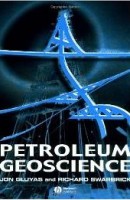Chapter 1: Introduction
First of all, the scope of the book is described together with a short description of what’s inside and outside of this scope. Secondly an introduction into the terminology is given. Terms like reservoir, petroleum and the trap are described shortly. The reader is moreover introduced into the timescales related to petroleum geosciences, after which the most common groups of hydrocarbons found in natural occurences of petroleum, like paraffins, naphtalenes and asphaltenes, are discussed. Finally the value chain of geoscience is presented.
Chapter 2: Tools
While performing his job, a geoscientist uses a wide range of tools to describe the distribution of rock, fluid and void in the earth’s subsurface. The basic technology of tools that should be familiar to geoscientists is introduced in this chapter. Among others, tools and data that are discussed are satellite images, seismic data and fluid samples from wells.
Chapter 3: Frontier Exploration
The first episode of exploration in a basin is described by the term frontier exploration. In this frontier exploration period, many of the primary questions regarding its geology are asked, and some are answered. Examples are:
What is the type of the basin?
Does the basin contain source rocks?
Are these rock mature for petroleum generation?
Where are the source rocks, reservoirs and seals?
What is the basin history?
In this chapter, the technical activities that accompany the entry of oil and gas exploration companies into a new basin are examined together with the questions raised above. In the end of the chapter, three cases are introduced which are good examples of real frontier exploration. Knowledge on exploration (mainly in chapter 3 & 4) is however prerequisite for these case studies.
Chapter 4: Exploration and Exploitation
If from the frontier exploration phase it can be understood that the field contains economically viable petroleum pools, then the work changes to go to the exploration and exploitation phase. During this stage, a lot of pools are discovered since only in this phase most of the understanding of the petroleum systems is obtained.
Chapter 5: Appraisal
The fields and pools that are found in the exploration phase are evaluated by their size and shape in the appraisal phase. The internal architecture of the reservoir including the porosity and the permeability are determined. Based on that data, the appraisal phase will end with the decision to either abandon the project or to take the field into production.
Chapter 6: Development and production
The role of the geoscientist in the process of field development, production, abandonment and reactivation is examined. This role is different of the role in the previous stages in the sense of the data that has to be interpreted. While in previous phases this was mainly static data helped describing the earth’s surface, now a lot of dynamic production data is generated. Another difference is that the timescales which are worked with are not in the order of years, but in the order of weeks.
In this chapter, development, production, changes to reservers and the economic criteria for abandonment of a field are illustrated by six case histories, mostly regarding fields in the UK area.





